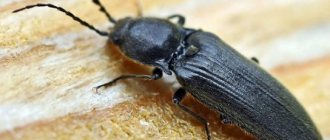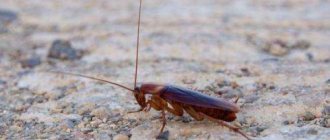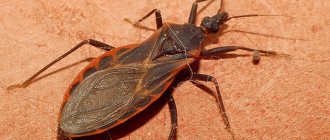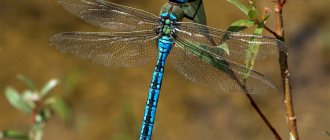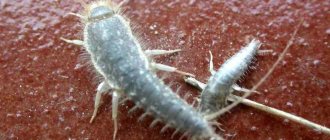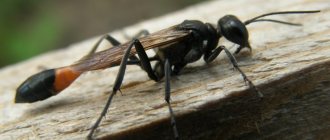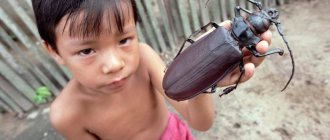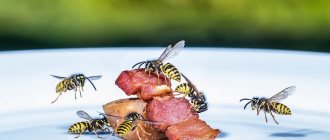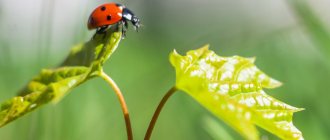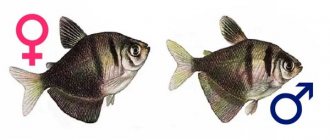People who are seriously and enthusiastically involved in gardening know examples of areas free from pests. In these areas, experienced and talented gardeners have created a biocenosis, a self-regulating system of natural balance. In this system, predatory insects, or entomophagous insects, play an important role, devouring insect pests. In an ordinary summer cottage, entomophagous insects are also able to significantly reduce the excesses of pests. In our article we will talk about the types of entomophagous insects, what pests they eat and how to lure them into the garden.
Distinctive features of a predator insect
A number of characteristics are identified to identify which insects are predators:
• these are organisms that eat several types of creatures; • both adults and larvae move quickly in search of food and prey; • can be parasites of larger organisms, but ultimately lead to the death of the host; • exhibit the qualities of a predator at all stages of maturation.
Don't think that these are scary, disgusting creatures. Most of these insects are harmless to humans. Many of them evoke a feeling of tenderness.
Plants
In many entomophages, larvae feed on pests, and adult insects eat nectar (some eat both nectar and pests). Therefore, entomophages choose to live in places where honey plants, umbellifers and cruciferous plants with small flowers grow.
The best plants to attract entomophages:
- dill;
- parsley;
- clover;
- onion;
- caraway;
- parsnip;
- carrot;
- oregano;
- St. John's wort;
- celery,
- sunflower;
- buckwheat;
- Vika;
- Tartar;
- tansy.
- daisies; daisies, marigolds (attract hoverflies).
These plants are planted along the edges of flower beds and tree trunks, forming flowering borders from them. It is advisable to plant plants so that they bloom, replacing each other, or give preference to those that bloom for a long time (basil, oregano, rosemary, hyssop, etc.)
The benefits of insect predators
Among this large group of carnivorous creatures, insect predators useful for agriculture stand out. Examples of these organisms can be found in any gardener's reference book. These include ladybugs, acarophages, anthocoria, spiders, and ants. Predatory insects are specially bred on land or in laboratories. They kill pests of beneficial cereals, legumes and green crops. Their beneficial qualities for gardeners are determined by what predatory insects feed on.
In the wild, they control the number of herbivorous relatives. By eating primarily sick and weakened individuals, insect predators push natural selection. Diseases within the community are prevented from developing to epidemic proportions. Insect predators provide significant benefits. The list of these carnivores is very diverse in terms of classes and characteristics.
Classification of beetles by family
Among all families, six are the most numerous. Their representatives make up more than 60% of the total number of beetles.
Weevils
They have a rostrum. This is the elongated front part of the head, at the end of which the mouth organs are located. Males have a shorter and wider tube, and they themselves are smaller than females.
There are two types of weevils:
- short-proboscis - develop in the soil, feed on roots and fallen leaves.
- long-proboscis - develop inside plant tissues, feed on the sap of shoots, leaves and flowers.
Based on their feeding habits, weevils can be:
- monophagous - feed on plants of the same or related genera;
- oligophagous - feed on plants of the same family;
- polyphagous - they eat plants of different families.
Weevils can cause great damage to agriculture. They destroy field, garden and vegetable crops by eating young plants and fruits. At the same time, some types of weevils are used to control the spread of weeds.
Rove beetles
The rove staphylinids or short-elytras are the world's largest family of animals. Rove beetles are found everywhere and have ancient origins. The size of most members of the family does not exceed 1 cm.
Lamellaridae
They are named so because of the special structure of the antennae. Each antenna consists of 3-7 segments with a common base and opens in the form of a fan. Lamellars are medium-sized. The largest species, the Hercules beetle, reaches 17 cm, and according to some descriptions - 22 cm.
Most species of lamellates are mole rats. They live in the soil, in separate deep burrows. Most of them are coprophages, eating animal excrement.
Ground beetles
A large family of beetles, the species of which have minor differences, and therefore it is impossible to determine their exact number. The type of ground beetle body shape depends on its habitat. Those living on sandy beaches are small and round, those living in grass stems have elongated bodies. The size of ground beetles ranges from 1 mm to 10 cm. They prefer areas with high humidity and low average annual temperatures. Most ground beetles are predators.
Leaf beetles
Mostly small and medium-sized, living on leaves. They can have different body shapes: oval, elongated, spherical. They can hide their antennae and paws underneath. Some types of leaf beetles are of economic importance: they are used to control weeds.
Barbels
A large family, all representatives of which have a characteristic distinguishing feature - long segmented mustaches. Most longhorned beetles are of medium size, but some of them can reach 17-20 cm. The record holder is the titanic longhorned beetle, some individuals of which grow up to 21 cm.
The antennae of longhorn beetles consist of 11-12 cylindrical segments. They are usually longer than the insect's body. The mustache of males is several times longer than that of females and is often injured during wrestling and mating games.
Ladybug
The cutest creature turns out to be a voracious predator. Picking it up in a meadow, tree or path, many have no idea what a ladybug is eating. Its main diet is aphids. Every day, a small bug eats more than a hundred of these pests of agricultural fields and vegetable gardens. A ladybug larva needs up to two thousand of these insects. The ladybug benefits farmers and regulates the number of aphids. This insect spends the winter in fallen leaves, tree bark, and mown grass. To attract ladybugs to your plot, you need to plant barley or alfalfa. You can buy these insects in specialized stores for quick, powerful control of aphids.
Shelters
Some entomophagous insects willingly settle in artificial shelters that gardeners make for them. For ground beetles, bricks, flat stones or pieces of plywood are laid out around the area, which are installed so that one end is raised above the ground by 1-1.5 cm. In these dugouts, the ground beetles will wait out the daytime, and at night they will crawl out on patrol to protect the garden frontiers.
To attract lacewings and some other entomophages, flower pots with drainage holes (bottom up) are hung on tree branches and filled with hay or simply dried grass. The hay is changed every spring.
In some areas of the garden it is recommended not to mow the grass. In such overgrown corners, where a layer of grass, leaves, etc. is created, entomophages settle for the winter.
Garden ground beetle
A very fast predator. A fairly large beetle with a bronze tint. Doesn't fly, but runs fast.
Loves light, non-acidic soils, dry grass and rotten leaves. The ground beetle larva is also distinguished by its high speed of movement. An excellent assistant for gardeners. Destroys larvae, caterpillars, snails and slugs. Mainly nocturnal. Lives in the top layer of soil under old leaves and fallen grass. Very active in search of food. Over the summer it can eat up to four hundred caterpillars, and the beetle larva is even more voracious. Experienced gardeners know the benefits of ladybugs and ground beetles on their site. Thanks to them, the use of chemicals to kill pests is significantly reduced, and this is a huge plus for human health.
In which countries do they eat insects?
Eating insects (entomophagy) is practiced in many countries. Today, dishes made from them are traditional in the countries of Asia, Africa, and Oceania. When you go on vacation to Thailand, South Korea, China, Japan, Botswana, Uganda, New Zealand or Australia, you can taste these delicacies. They are served in cafes and restaurants raw, as well as prepared according to unusual recipes.
Eating insects is practiced in many countries around the world.
Today, more and more European people are beginning to include insects and dishes made from them in their menu. The main reason for this is the understanding of the benefits of environmentally friendly and amino acid-rich protein foods. Many European farmers are switching from classical animal husbandry to insect farming. Food made from beetles is becoming popular in Russia, but usually only those sold as supplements. Powder from locusts, grasshoppers or beetles is added to dairy, meat and flour products, as a result of which their nutritional value and benefits increase.
Natural protein supplements are made from edible insects
Common lacewing
Belongs to the class of lacewing insects. It has large wings with a green tint.
Eats the same thing that a ladybug eats. Loves the sweet secretions of aphids. The lacewing larva eats the aphids themselves in very large quantities. It destroys up to one hundred aphids per day. The common lacewing will bring great benefits to the garden. In addition to aphids, it copes well with poutine mites, leaf rollers, carrot, onion and cabbage flies, caterpillars and scale insects. To maintain the number of lacewings on the site, special houses with bait for these insects are used, care is taken to provide a place for wintering, and early flowering plants are bred for food after hibernation.
Dragonfly
At least once in their life, every person has looked at this insect. Particularly attractive are the beautiful iridescent wings and the mask on the head. When you see a powerful retractable jaw, the question does not arise: is a dragonfly a predatory insect or not? This is a fast flying predator. Lives near bodies of water. Leads a mostly solitary lifestyle. It feeds on mosquitoes, small flies and bugs. Pursuing the victim, it is capable of accelerating up to eighty kilometers per hour. With tenacious paws it grabs the victim in flight and deals with it with the help of its powerful jaw. Dragonflies differ in the shape of their wings, the location of the aircraft and the length of the body, but in all of them the larva leads a long aquatic lifestyle. Some species spend more than five years in this stage. The dragonfly larva is a predatory insect of water bodies. Sedentary, but very voracious. It feeds on mosquito larvae, beetles and fry. The long-winged beauty itself is subject to attacks by fish, birds and large insects. Therefore, the number of dragonflies is not so large.
Number of meals
Ants feed quite often, two to three times a day. Foraging ants, which search for and deliver food to the anthill, usually manage to eat part of the transported “products” along the way. In the anthills themselves, livestock insects can live, which secrete honeydew, which is very popular among ants. In return, the insects allow their neighbors to eat their eggs.
In winter, they usually hibernate or starve. Some create food reserves that they eat all winter. In most northern regions of Russia, ants can go without food for up to nine months.
In the southern regions of our country, harvester ants can collect up to several kilograms of seeds, which are then distributed throughout the winter.
During the hungry months, the uterus can “give birth” to so-called trophic eggs. They cannot transform into a larva, and serve purely as food for ordinary anthill workers.
You can also find out what ants mean in dreams from this article.
Mantis
The insect is a beautiful green, brown or yellow hue with an interesting pose of the front legs. They are raised upward, as in prayer. Hence the name of the insect. The raised legs of a praying mantis mean a threat to anyone who wants to attack it. This gesture shows that it is better not to approach. Also, raised paws mean that the praying mantis is hunting. On the outer side of the limbs there are sharp, blade-like spines for striking the victim.
Acute vision and the ability to turn their heads 180 degrees help praying mantises hunt. They always see where everything is happening. When eating a victim, the mantis does not relax, so as not to become dinner itself. His movements are slow and unhurried.
Mantises are not dangerous to humans, although they reach 15 cm in length. He is indifferent to non-moving objects. Its diet consists of small rodents, birds, bees, lizards, small snakes, frogs and various insects. Often praying mantises eat their relatives if there is not enough other food. After mating, the female bites off the male's head to satisfy her hunger. Praying mantises are cunning, merciless and voracious predators. The larva is capable of eating up to 5-7 aphids per day. An adult mantis is always hungry. It eats 7-8 medium beetles per day.
Insect dishes
Most insects can be eaten raw, but it is tastier and healthier to cook various dishes from them. Restaurant menus in some countries include insect food, which is appreciated by true gourmets. Let's look at several recipes for preparing various beetles, worms, caterpillars and larvae.
Food from silkworm larvae
Silkworm larvae are a tasty delicacy that resembles the consistency of scrambled eggs or mozzarella wrapped in puff pastry. 100 grams of this product contains 10-17 g of protein, and the miniature ecosystems where the larvae grow and develop can become an almost endless source of protein.
Cooked silkworm larvae resemble nuts and taste like scrambled eggs.
Gourmets can eat them raw or cooked, grilling them over charcoal or over an open fire. In China and Vietnam, silkworm larvae are considered a rare delicacy. In Korea, they are used to prepare the dish ppondegi, which consists of steamed larvae with the addition of spices.
In Japan, silkworm larvae are boiled in soy sauce with seaweed, adding a little sugar and sake.
Fly food
Both adult flies and their larvae are suitable for consumption. This is a valuable protein product that the Indians loved. They were cooked in the oven and served raw, and they were also made from flies into cucciabi, a mass that could be cut with a knife.
Cucciabi - a delicious dish made from flies
Today flies, as well as fruits with fruit fly larvae, are eaten in Hawaii. In Asian countries, a signature dish is fried rice with fly larvae. To prepare it, boiled rice is mixed with fried larvae, finely chopped garlic, pieces of pepper, seasoned with coriander, soy sauce, sugar, and onion. And in Mexico they love to eat mayflies as a snack.
2 recipes for fried cockroaches
Since ancient times, cockroaches have been consumed as food by residents of Madagascar, China, South America and other countries. Today they are bred on special farms and prepared according to two popular recipes:
- Heat oil in a frying pan, add a few cloves of garlic and half a teaspoon of rosemary. Then add cockroaches and fry them for 5 minutes. The dish is served on the table without oil, sprinkled with salt.
- Cockroaches are placed on a preheated frying pan. Place 150 g of butter, grated garlic, a little salt and pepper on top. Then fry covered for about 5 minutes.
Fried cockroaches turn out dry and crispy in taste.
Before cooking cockroaches, you need to keep them in the freezer for an hour so that they fall asleep and do not jump out. You should also remove all paws, antennae and shell, wash and dry thoroughly.
Caterpillar dishes
Caterpillar meat is rich in vitamins and protein, and tastes like tea leaves or dried tofu. They are usually cooked in a frying pan, frying them in oil, and also smoked, pickled, stewed, added to soups, porridges, and sauces made from caterpillars. There are 38 species of edible caterpillars in the world, one of the most common is mopane. They are collected during the Christmas holidays in southern Africa and supplied to different countries. The largest importers of mopane caterpillars are Belgium and France.
Caterpillars can be prepared in a variety of ways.
Cheese with cheese fly larvae
On the Italian island of Sardinia, Casu marzu cheese is made, which contains cheese fly larvae. They eat the inside of the cheese, laying eggs in it. Despite the fact that for many it is nothing more than “rotten cheese with worms,” there are many lovers of this delicacy in the world.
Casu marzu cheese is made from live cheese fly larvae
Boiled bees and wasps
Bees boiled in soy sauce are popular in China. They began to be eaten after the war, when other products were in short supply. They are still eaten today, served with rice, which perfectly complements the taste of the delicacy.
Water bugs in creamy sauce
This dish is prepared in Thailand. Water bugs are caught, washed, dried and deep-fried. Served with traditional cream sauce.
Those who have tried the delicacy compare its taste to shrimp.
Water bugs in creamy sauce - a popular Thai dish
Grilled dragonflies
For consumption, large dragonflies are selected, which are caught, wings removed and grilled. They can be served either without additives or with various sauces.
Fried tarantulas
Giant spiders can only be feared when they are alive. And if you fry them in a frying pan, adding butter, salt and a little pepper, they will become an excellent protein dish that tastes like meat or fish.
Pizza with rhinoceros beetle larvae
This pizza is no more difficult to prepare than regular pizza. First you need to make the dough by mixing 1.5 cups of flour with an egg, butter and salt. Then put it in the refrigerator for half an hour, then roll it out and lay out the filling: chopped bell pepper, onion, 2 tomatoes, 20 fried rhinoceros beetle larvae, 200 grams of grated cheese, tomato paste and mayonnaise. The pizza should be baked for 20 minutes.
Pizza with rhinoceros beetle larvae and fried tarantulas
Earthworm cutlets
To prepare 4 servings of this dish, you need to take 700 g of worms, 150 g of butter, 1 tsp. lemon zest, 1 egg, a little sour cream and breadcrumbs.
The worms need to be washed and boiled, then turned into minced meat using a blender, added lemon zest and formed into cutlets. Dip them in egg and breadcrumbs, fry in butter. It is advisable to serve the dish with sour cream and fresh vegetables.
Earthworm cutlets
Salad with fried grasshoppers
For the salad you need to take beets, carrots, walnuts, grasshoppers, olive oil and salt. The insects should be prepared first - remove the hind legs, then fry and grind together with walnuts in a blender. Grate beets and carrots on a coarse grater, add a mixture of nuts and fried grasshoppers, season with olive oil. If desired, you can add salt and a little ground black pepper.
Salad with fried grasshoppers
Fried ants
This is a popular dish in Asian countries that is very simple to prepare. Ants need to be put on a stick and baked over an open fire. In Colombia, fried ants are sold in movie theaters instead of popcorn.
Fried ants
Ant kebab tastes like nuts.
Cookies with crispy crickets and coconut/chocolate chips
For 12 cookies you will need 50 fried crickets, 400 g flour, 200 g sugar, 50 g coconut, 1 egg, a pinch of salt, 1 tsp. soda, a little butter. Mix flour, soda and salt, separately beat the egg with sugar, coconut flakes and 2/3 of the crickets. Combine the two mixtures, mix and form cookies. Bake the products for 15 minutes on a preheated and greased baking sheet.
Cookies with crickets
Crickets in chocolate
This unusual dessert will be an excellent gift for a true gourmet. You can buy chocolate-covered crickets ready-made or make your own. For the second option, you need to wash, dry and fry the crickets, dip them in melted chocolate and allow time to harden. You can make candies by pouring chocolate into molds and placing a fried or baked cricket inside each one.
Crickets in chocolate
Mealworm Cupcakes
Cupcakes with an unusual ingredient are already baked in some countries, for example, in Latvia. They are prepared in the same way as regular muffins, but some of the flour is replaced with mealworm powder. As a result, baked goods are more healthy due to increased protein, vitamins and amino acids content.
Mealworm Cupcakes
Fried bamboo worms
Thais often eat bamboo worms for lunch or dinner. In general, these are not exactly worms, but larvae of grass moths that live in bamboo. They are collected by cutting bamboo stems, washed, fried in oil, packaged in bags and sold. This delicacy can be tried in China, Thailand, and Latin America.
Bamboo worms are imported by England and some other countries.
Fried bamboo worms
Shish kebab from longhorned beetle larvae
Longhorned beetles are found throughout the world. These are large beetles with long antennae-like antennae that lay large larvae. Longhorned beetle larvae skewers are a common delicacy in Eastern Indonesia. Local residents catch them, string them on twigs, roast them over an open fire and eat them with pleasure. The larvae have tender flesh and elastic skin; they taste like fatty bacon.
Shish kebab from longhorned beetle larvae
Dried mopane caterpillars with onions
In South Africa they prepare an unusual dish - dried mopane caterpillars with onions. For Africans, this is one of the main sources of protein, and collecting caterpillars is a serious business and can bring good income. In markets and stores you can buy raw, dried, pickled and smoked caterpillars. The caterpillars are prepared by hand: first, the intestines are squeezed out, then boiled in salted water and dried. They taste like tofu or dry wood, so they are often fried with onions to improve their taste.
Dried mopane caterpillars with onions
Mealworms with vegetables and rice
To prepare a dish for 4 servings you will need 200 g of rice (preferably long grain), 1 cup of worms, 1 onion, 1 leek, 1 sweet pepper, 2 carrots, a little vegetable oil, 4 tbsp. l. soy sauce, green onions, pepper and salt to taste.
Boil the rice in salted water, chop the leeks and onions and fry them in oil, add grated carrots, and a little later add thinly sliced peppers. Simmer for 10 minutes over low heat, then mix with rice, season with soy sauce, pepper and salt.
Mealworms with rice - a traditional dish of Asian countries
Next you need to prepare the mealworms. They should be fried in vegetable oil until they increase in size. Then season them with salt and pepper, mix with rice and simmer the whole dish over medium heat for another 5-7 minutes. It is recommended to serve it hot, garnished with green onions.
Deep fried water bugs
Residents of the Philippines and Thailand eat waterbugs. These insects taste like crab meat and do not lag behind them in nutritional value. To cook water bugs, you must first wash, dry and fry them in hot oil. The dish is best served with soy sauce.
Grasshoppers with avocado
The most popular dish of these insects is grasshoppers with avocado. For Mexicans, this is practically their national food. To prepare this dish, grasshoppers need to be fried, mixed with avocado and spread on a corn tortilla. The taste and aroma of this delicacy is outstanding.
Grasshoppers with avocado are sold on the streets in Southeast Asia, and you can find the delicacy in other countries.
Grasshoppers with avocado and deep-fried water bugs
Dragonflies in coconut milk
To prepare such an unusual dish, you need to catch dragonflies using sticks coated with glue, and then fry them in coconut milk, adding sugar. The result is caramel on a stick with an unusual taste and valuable composition.
Mealworm Ice Cream
You can prepare an unusual dessert from mealworms yourself.
To do this, you need to take a glass of chopped worms, add 100 g of melted butter, a spoonful of honey and the same amount of sugar, then beat the mixture in a mixer. Then add a few drops of rum and sherry and boil for 5 minutes. After this, rub the mixture through a sieve and, reducing the heat to low, keep it on the stove until the composition thickens. The final touch is to add a spoonful of lemon juice and refrigerate until cool. This dish is unique in that no one will guess what it is made from.
Ice cream with worms - an extravagant treat
Bugs with chicken pate
Grass bugs have a pungent odor that not everyone likes. In some countries, they are eaten by first soaking them in water for a long time and drying them in the sun. But in Mexico they love the scent of these insects and happily eat grass bugs. They are fried over high heat and then mixed with chicken pate.
Tarantulas baked on coals
One of the common dishes in Cambodia is tarantulas, grilled until black on coals. The spiders are fried in a wok, adding salt and pepper. In large tarantulas, the abdomen is first cut open, the hairs are singed and fried in tempura. Lucky catchers can catch about 200 individuals a day and sell them in a couple of hours at the market.
Fried tarantulas - a delicacy in Cambodia
Wasp
There are more than 100 thousand species of these insects. They are similar in structure, but differ in the way they organize life.
There are loners, social colonies and parasites. They are different from bees. Wasps are large insects with a well-developed jaw apparatus and a reusable sting. Having stung once, the wasp will not die. This is the answer to the question: “Is a wasp a predatory insect or not?” The diet of the adult and larvae includes small bugs, caterpillars and spiders. The wasp injects poison into the body of the victim, which paralyzes and immobilizes future food. Then he brings her to his house. Parasitic wasps use the paralyzed body of the victim to lay eggs so that the young have something to eat. A paralyzed individual does not die for a long time and remains fresh.
Wasps are beneficial to gardeners. They kill a lot of caterpillars, spiders, mites, and harmful worms.
Not everyone enjoys being around wasps. Among them there are giants - these are hornets. Large, with a loud buzz, living in colonies, they become unpleasant neighbors if they settle under the roof of a house, eaves or attic.
Wasps don't just attack humans. If they feel threatened, then the entire colony's army is ready to launch a preemptive strike.
Reproduction
Full Development: Stag Beetle
Reproduction in most insects is accompanied by mating and fertilization and is associated with the participation of two sexes. However, insects also have other methods of reproduction:
- viviparity - the eggs mature in the female’s body, and the larvae immediately emerge (for example, in Madagascar and a number of other cockroaches). To the observer, it looks as if the insect is “giving birth,” but this process is completely different from gestation in humans and higher mammals.
- parthenogenesis - reproduction without the participation of a male, when the female lays unfertilized eggs, and larvae emerge from them. It is very common among stick insects, but is also found in many other groups - in cockroaches, mantises, and all social insects (in bees, wasps, ants, and bumblebees, working individuals appear precisely from unfertilized eggs).
- pedogenesis is a special case of parthenogenesis, the ability to reproduce at the larval stage. Found in fanwings, micromalthus beetles, gall midges and bagworms.
- polyembryony - the development of several embryos from one zygote. Interestingly, in addition to insects, it is also observed in armadillos and bryozoans.
Bug
Not all bedbugs are predators. Among them there are herbivorous species and individuals with a mixed diet. The most prominent representatives of carnivorous mites are anthocoris, orius and reduviida. At all stages of life, they actively feed on aphids, thrips, whiteflies, spider mites and spiders, eggs of butterflies and beetles. Rhodius bugs feed on eggs, larvae and adults of the Colorado potato beetle. Macrolophus destroy the greenhouse pest - whitefly.
They are actively used in agriculture for pest control. But bedbugs need a lot of food. Having destroyed all the pests, they will change their habitat.
The most common entomophagous insects
26 species of entomophagous insects have been registered in Russia, and they are used with great success in industrial horticulture and vegetable growing, and in greenhouses. In open ground, much smaller amounts of entomophages can be used, but they can protect plants from pests better than pesticides. Here are the most common and effective insects:
| Entomophage | What pests does it destroy? |
| ladybugs | Leaf aphids, oribatid aphids, spider mites, scale insects and false scale insects, psyllids, coccids, mites. |
| Gallica | Various types of aphids. |
| Ground beetle | Cutworm caterpillars, codling moths, moths, hawthorns, vegetable fly eggs. |
| hoverfly | Aphid |
| Rider | Butterfly caterpillars, fly larvae, aphids, apple moths. |
| Soft-bodied beetles (firefighters) | Various caterpillars, aphids, small slugs. |
| Pied beetles (beetles), (bee ants). | Bark beetles, longhorned beetles, grinders, weevils, etc. |
| Lacewing | Whitefly, aphids, etc. |
As you can see, there are no ants in this table. For them, aphids are a pet, which they care for like shepherds for a flock.
Polinka Moderator FORUMHOUSE
For ants, aphids are a natural cash cow, and the milk is the sweet “juice” that the gorged aphid secretes. To “milk” the ant, it is enough to tickle the aphid. The ants protect the aphids and transfer them to richer pastures (fresh plants) so that the aphids grow fat and provide milk to the ants. Bastards...
But we should dwell in more detail on the most common species of entomophagous insects in our latitudes.
Water strider bug
Active predatory insect of water bodies.
With the help of sensitive receptors on its legs and antennae, it detects the slightest vibrations in the water and rushes there in search of food. Hunts flies, mosquitoes, horseflies, and insects that have fallen into the water. Eats clutches of eggs in water and on land, near a reservoir. In the middle zone, the water strider bug is not dangerous to humans. In tropical climates, these individuals are much larger and have a poisonous gland. The sting is very painful, similar to a bee.
Wednesday
Different types of entomophages require different conditions.
| Entomophages | Attractive environment |
| Ground beetles | Moist shaded areas, tall grass next to bushes and trees. From these dark corners, ground beetles go out at night to hunt flower beds and flower beds. |
| Hoverflies | It is extremely important to have early flowering plants in the garden, such as coltsfoot and even the weedy dandelion. The sooner they find nectar, the sooner the larvae will appear. If there is no nectar in the spring, larvae may not be expected until August. |
| Lacewings | Thickets of ferns, evergreen shrubs and other cool places in partial shade where lacewings lay their eggs. |
FORUMHOUSE has many supporters of organic farming who prefer to collaborate with nature, including beneficial insects. Read our article about permaculture: a method in which plants are planted to help each other grow and protect themselves from pests. Watch our video with an overview of new products for gardening.
Common earwig
The terrifying appearance with two tentacles on the back of the body frightens many gardeners. In fact, all the fables about the poisonousness and jumping ability of the earwig are fiction. Has a mixed type of nutrition. Lives in the top layer of soil. It digs many holes in the ground, causing damage to the roots of cultivated plants. It gnaws the roots and stems of plants, leaves and flowers. Hunts spider mites, spiders, caterpillars, worms. Loves aphids. Harmless to humans. The benefits for agriculture are twofold. Kills pests, but in the process of life it causes harm to cultivated plants.
Ecology DIRECTORY
Predatory insects, such as ground beetles (Carabidae), jumping beetles (Cicindelidae), and antlion larvae (Myrmeleonidae), usually have large upper jaws.[...]
A predatory insect with a long thin body and two pairs of transparent wings that produce a characteristic noise when flying. [...]
Insects (beetles, bedbugs, mosquito larvae), feeding on the same food as fish, cause known damage to their food supply. For example, the predatory larva of the mosquito Procladius choreus Meig. destroys the larvae of other mosquito mosquitoes in quantities amounting to 72-188% of its own weight; and since the number of Procladius larvae is very high, they can quite strongly influence the food supply of fish. Intensity of grazing by Procladius choreus Meig. larvae of other mosquitoes varies depending on the nature of the soil (Belyavskaya and Konstantinov, 1956).[...]
Predatory insects that grab their prey with their upper jaws—jumping beetles (family Clifflehnsae), many ground beetles (Carabidae), etc., or gnawing off parts of plants with them—cracker beetles (LeMte sp. er.), etc., have large upper jaws. In dragonfly larvae (Oc1opa1a), which catch their prey using the lower lip, the latter has changed into a special organ “mask” (Fig. 57).[...]
Predatory insects usually do not attack representatives of their own species, but some, under certain conditions (especially in the case of a lack of food), devour them too. This phenomenon is called cannibalism. Many coccinellid beetles (Coccinellidae), for example, when there is a lack of food, eat the eggs they lay; cannibalism was noted in Formicidae ants) (Escherich, 1906). Cannibalism is very common in predatory larvae of mosquitoes of the subfamily Chaoborinae and especially in the genus Cryophia (Monchadsky, 1959). Sometimes cannibalism is observed not only in predatory insects, but also in herbivores, such as the bollworm (Chloridea obsoleta F.), the winter worm (Agrotis segetum Schiff.) or the small mealworm (Tribolium confusum Duv.).[... ]
Insects that use cracks, cavities and channels for movement in the soil that exceed the thickness of their body (for example, passages made by other insects, or voids preserved from plant roots) have a campodeoid shape, characterized by a straight, not bent body, wider in the front. , long running legs, often also a large head. Campodeoid larvae are characteristic, for example, of ground beetles (Carabidae), predators Staphylinidae, predatory lacewings (Neuroptera); Campodeoid triungulins of t-shirts (Meloe sp. sp.), blisters (Mylabris sp. sp.) and spanks (Epicauta sp. sp.). Such insects are capable of rapid movement in voids and soil.[...]
Animals of prey include insectivorous birds, frogs, toads, hedgehogs, ants, ladybugs, ground beetles, etc. Predators eat their prey immediately. Parasites (entomophages) lay eggs in host tissue (eggs, larvae, pupae and adult insects). The hatched larva of the parasite feeds on the internal tissues of the host, gradually causing its death. In the adult phase, parasitic insects lead a free lifestyle, feeding on the nectar of flowering plants. The most common entomophages are Trichogramma, Telenomus, etc. [...]
Among insects there are predatory and parasitic species, collectively called entomophagosis. Predators are those species that attack and eat others. Parasites lay eggs outside or inside the body of another insect, and their larvae feed on the host. Parasites are most often confined to the development of a specific phase of the host. According to their nutritional specialization, they, like phytophages, are divided into monophages, oligophages and polyphages.[...]
Other predatory animals eat insects in most cases also during all periods of their active life, but some of them are insectivores only at certain ages. Amphibians, for example, feed on insects only in older larval instars and in the imaginal stage; sparrows (Passer domesticus L., pink starling (Pastor roseus L.) destroy insects mainly during the period of feeding their chicks. [...]
Some insects lead a predatory lifestyle only in the larval phase of development; such, for example, are the dipterans of the genus Leticopis Mg., many species of the family Syrphidae or some Lepidoptera (the armyworm OratoceUs communimacula Hb., the moth Alophia combustella HS, etc.), but for most predatory insects this feeding method is also characteristic in the imaginal phase.[...]
Birds of prey are very different in size, but in our fauna there are no small species, there are medium ones, slightly smaller in size than a pigeon, and larger ones - up to an eagle. Some predators, in the process of species formation, so modified their way of life that they completely stopped predating and began to feed on carrion; many feed mainly on insects. [...]
Entomophages—predatory and parasitic insects—are used in two ways. The first is their artificial breeding and release into the fields. The number of entomophages suitable for this is extremely small, which is due to the complexity of mass breeding of the absolute majority of species. Only two species are widely used for plant protection: the Trichogramma ovitaea against harmful lepidoptera and the predatory phytoseiulus mite, which destroys spider mites in greenhouses.[...]
Insectivores and birds of prey eat insects, slugs, and rodents. Some mammals (hedgehogs, shrews, moles, bats, etc.) also destroy insects. They are destroyed by lizards and many snakes, but they do not play a significant role in the fluctuation in the number of harmful insects.[...]
The relationship between predatory and peaceful fish is clear, but they also have common enemies. Thus, in the early stage of development, eggs, larvae and fry are destroyed by beetles, frogs, and various insects. The grown-up fish are in wait for leeches and mites, which eat into the body of the fish or stick to it and deplete the body. Significant damage to the adult generation of fish is caused by birds - herons, cormorants, gulls, ducks, etc. Some damage to fish schools is caused by mammals such as the otter, water rat, etc. [...]
Dragonflies are large predatory insects, the larvae of which develop primarily in stagnant or slowly flowing bodies of water. The ecological requirements of dragonflies from different taxa are different, which makes these insects promising in terms of biological indication of water quality. [...]
Probably, some predatory insects originated from saprophages and necrophages (some larvae of Diptera, some beetles and their larvae of the family Staphylinidae, etc.).[...]
During the flowering period, a loose raceme of irregular shape with orange-yellow flowers is thrown out over the water. The leaves have special growths of tissue in the form of bubbles, which serve as original devices for catching small aquatic insects and fry.[...]
An analysis of the literature shows that the main condition for increasing their activity is sowing nectar plants: phacelia, mustard, carrot seeds, parsnips, parsley, onions, etc. To attract beneficial insects to gardens and vegetable gardens and increase their life expectancy and fertility, it is recommended to create a flower-nectar plant conveyor - sowing between rows at different times of phacelia, buckwheat, mustard and other nectar plants.[...]
INSECTIVOROUS (carnivorous) PLANTS - an ecological group of autotrophic plants (about 500 species) capable of capturing insects and partially digesting them with the help of enzymes and organic acids, as a result of which they compensate for the lack of nitrogen and other nutrients in the substrate. Raised bogs receive water from precipitation and are therefore extremely poor in nutrients; There are few flowering plants here; round-leaved sundew is found in communities with woodland, sedge, whiteberry, blueberry, cranberry, etc. The upper swamps of North America are inhabited by an insectivorous plant - purple sarracenia with very peculiar leaves. [...]
To suppress the development of predatory aquatic insects in ponds, film-forming substances can be used. It is a dark amber liquid obtained by processing paraffin. When added to water, it forms a film one molecule thick on its surface. This causes the death of insects breathing atmospheric air. To treat 1 hectare of pond, 0.7... 1 kg of VLS is required. In Hungary, for the selective breeding of zooplankton, chemical substances containing esters of phosphoric acid are used - ditrifon, flybol E. At a concentration of 100 mg per 1 m3 of pond water, these drugs destroy daphnia and cyclops, but have no effect on rotifers. [...]
Microorganisms to combat harmful insects, rodents and plant pathogens are used on the basis of created biological preparations. Their important advantage is that in the dosages used they are harmless to plants, humans, warm-blooded animals, parasitic and predatory insects, bees and other beneficial organisms. They have a long-lasting and destructive effect on the offspring of harmful organisms.[...]
In many species of living organisms (birds, insects, reptiles, animals, etc.), vibration receptors are among the most important life support systems and vital functions. Thus, predatory fish, even with loss of vision, have the ability to accurately determine the location of the prey by the amplitude-frequency characteristics of the oscillations caused by the movements of the prey.[...]
This includes predatory mites, some insects and spiders.[...]
Use of entomophages. Parasitic and predatory insects that live off harmful species have rightly received much attention (Sweetman 1964, De Bach 1968). Their use is possible only on the basis of in-depth studies of the biological and ecological characteristics of beneficial and harmful organisms, taking into account the complex and constantly changing relationships between the inhabitants of forest biocenoses.[...]
Ant trail pheromones can be perceived by predatory insects, which follow the odorous path left by the ants and follow prey directly to their nest. This is done, for example, by anteater beetles from the families Hysteridae, Staphnidae and Limulodidae [442].[...]
Most other insects, especially predatory ones, and primarily the red wood ant, are subject to special protection. Protecting anthills from destruction, prohibiting the collection of their pupae (“ant eggs”), and experiments in breeding and relocating ants are only the first steps towards their reliable protection.[...]
Campodeoid larvae belong mainly to predatory insects that eat crop pests (ground beetles, lacewing larvae). They are very mobile, dark in color, with a head extended forward and three pairs of long legs located on the chest.[...]
Of the large number of beneficial predatory insects living in the forest, only red forest ants can practically be used to prevent outbreaks of reproduction of pine-leaf-gnawing pests. The ants most intensively destroy the pine moth, pine cutworm, pine silkworm and star-shaped sawfly weaver; less intensively - pine sawflies and leaf-eating pests. A small or bare-backed ant of an aggressive shape protects trees from being eaten within a radius of 25-30 m; ordinary red and small, but not aggressive in shape - within a radius of 10-15 m around the anthill. The importance of ants is especially great during the period of increasing pest numbers.[...]
The biological method is based on the fact that harmful insects and other pests of fruit, berry and grape plants, capable of multiplying very quickly, have numerous natural enemies - predators and parasites, which cannot completely protect the plants from damage, but still due to their high gluttony significantly hinder their development. These are pathogenic microorganisms (fungi, bacteria, viruses), predatory and parasitic insects and mites, as well as insectivorous and birds of prey, bats, moles, hedgehogs, frogs, lizards, etc. [...]
Almost all types of birds are beneficial. They eat many harmful insects, and predatory bird species destroy mouse-like rodents.[...]
A very interesting type of relationship between plants and insects is observed in carnivorous (“predatory”) plants. About 450 species of these plants are known, growing in different climatic zones and using a wide variety of types of traps. Prey is attracted to the traps by the smell of fragrant substances or droplets of nectar; Both the plant’s own enzymes and symbiotic bacteria can participate in its digestion. In tropical plants Nepenthes, on the inner surface of the cone-shaped trap there are specialized digestive glands (up to 6000 glands per 1 cm2), which secrete proteolytic enzymes. The secretion of these enzymes is caused by the insect touching the inner surface of the trap.[...]
Hunting behavior. In experiments studying the hunting behavior of predatory insects, throwing reactions to prey are often studied. Repeatedly experiments were carried out on larvae of dragonflies of the genus Aeschna, which have good eyesight and lead an open lifestyle. When capturing prey, the larva throws out its mask, which is easily recorded by an observer. It is also very important that the larva can try to capture not only small aquatic animals, but in the conditions of the experiment and the prey model - small moving objects. The use of models allows the larvae to be presented with objects with specified parameters: size, color, etc.[...]
The origin of predation is also not uniform. In some cases, predation apparently arose in insects from phytophagy. For example, the bug Camptobrochis punctulatus Fall., found in large numbers in the alfalfa fields of Central Asia, feeds on plant juices, but, in addition, attacks aphids Aphis laburni Kltnb., Therioaphis ononidis Kltnb., Acyrthosiphon onobrychis Fons. Some other bugs of this genus lead a constantly predatory lifestyle. Facultative predators are some earwigs (Dermaptera) and grasshoppers (Tettigoniidae).[...]
The larva of the hoverfly destroys up to 200 aphids in 1 day. Plant pests are destroyed by ground beetles, soft beetle larvae, predatory parasitic nematodes, predatory mites, spiders, centipedes, dragonflies, etc. Most species of ants are also beneficial predators, with the exception of the black garden ant, which feeds on the secretions of aphids. Parasites include thin hymenopteran insects. They feed their offspring at the expense of other insects. Some of them lay their eggs in the eggs of other insects and are called egg eaters, others (riders) parasitize inside or outside the pests. [...]
Benthic animals live on the surface or in the upper layer of lake sediments. Among them there are both peaceful and predatory organisms. Peaceful zoobenthos feeds mainly on detritus or small silt particles of bottom sediments. The benthofauna of shallow areas of the reservoir is richest, which is due to the diversity of soils, better heating of the water mass, and the abundance of phytoplankton, after the death of which detritus rich in organic matter is formed. The poverty of benthic communities in the central deep-water areas of large lakes, in addition to the monotony of soils, is determined by two more important factors. In addition, insect larvae (chironomids) cannot live in deep and remote areas of the lake bottom, since they need favorable conditions for the emergence of adult stages of insects. That is why at depths greater than 100 m, oligochaetes predominate. [...]
The most well-known ability for biological accumulation is DDT, a substance previously widely used to control harmful insects and currently prohibited for use. Y. Odum (1975) gives an example of how underestimation of the patterns of biological accumulation caused by environmental processes led to the death of birds feeding on aquatic organisms, although they pollinated mosquitoes in the swamps of Long Island (Florida Peninsula), giving a concentration of DDT significantly lower than the dose, lethal to fish and other animals. He explains this by the fact that toxic sediments were adsorbed on detritus, concentrated in the tissues of decomposers (detritivores) and small fish, and then in predators such as fish-eating birds. Due to repeated absorption from the beginning of the detritus chain, the poison accumulated in the fatty deposits of fish and birds. And even if its dose was lower than lethal and the birds did not die themselves, DDT prevented the formation of eggshells: the thin shell bursts even before the chick develops. Such phenomena can lead to the destruction of entire populations of birds of prey, for example, osprey.[...]
Natural enemies are also used. Gypsy moth caterpillars are destroyed by cuckoos, orioles, woodpeckers and other insectivorous birds; predatory and parasitic insects destroy eggs, caterpillars and pupae.[...]
Novosibirsk: Science.[...]
An effective organophosphorus acaricide, Alkatox, has also been developed in Hungary. The drug is currently undergoing field trials. It is harmless to most predatory and beneficial insects and moderately toxic to mammals.[...]
The connections between nutrition cycles that determine the complex structure of the biocenosis can be seen in Fig. 10, where a number of food chains are visible, interconnected in cycles, for example: vegetation - insects - insectivorous birds - harriers; or vegetation - small insects - predatory insects and phalanges - toads - rattlesnakes. If we decipher these materials in terms of species, rather than groups, then the number of interconnected food chains will turn out to be very large.[...]
Therefore, when pesticides are used on a large scale, the general structure of the biocenosis and its inherent regulatory mechanisms are disrupted. In a number of cases, a paradoxical phenomenon was recorded—the use of pesticides led to an increase in the number of pests due to the destruction of their natural enemies and pests. Transmitted through the food chain, toxins contribute to the death of predatory animals and birds, and also accumulate in food products consumed by humans. The search for a solution to this acute problem is seen in two directions: the creation of insecticides and herbicides of narrowed action and the development of biological (nocoenotic) methods for limiting the number of species harmful in given conditions. [...]
The same problem - high cost due to the lack of specially developed industrial technologies - also hinders the development of biological methods for combating outbreaks of insect pests. For the widespread use of biomethods, it is necessary to be able to breed predatory and parasitic insects in biofactories in order to release the required amount of them at the right time onto fields that are threatened by mass reproduction of pests. However, the need for such biofactories can be significantly reduced by creating a land use system in which self-sustaining biocenoses can interact with polycultural agrocenoses. For example, forest shelterbelts and roadside bushes significantly reduce the damage caused by insect pests by creating breeding grounds for predatory insects and insectivorous birds. Huge, horizon-reaching fields of monocultures have never been part of the traditions of indigenous farmers. The ease of their mechanical processing is a seeming advantage, since it is many times offset by losses in land and product quality. Apparently, this stage of agricultural development is becoming obsolete.[...]
Small groups or individual wind-fallen trees and dead wood are an integral part of the natural biogeocenoses of a coniferous forest. They contribute to the regeneration of bedrock, preserve populations of predatory insects, etc. However, the consequences of the destruction of the tree stand on large areas by windblow, fire or clear cutting cannot be eliminated with the help of feedbacks - in such cases, the “repair mechanism” will work - restorative successions, in which soft-leaved pioneer species that form derivative forests play an important role. Restorative successions usually do not push the biogeocenosis beyond the limits of stability, and after a long period, indigenous forest communities are restored. This period is significantly shortened by crops of the main breeds. The general principles of the organization of forest ecosystems during “repair” are preserved, and vegetation succession does not change the affiliation of the biogeocenosis to the main typological subdivision.[…]
Accumulators of these compounds primarily include birds of prey (kite, eagle owl, owl, harrier, hawk, owl, etc.) and insectivores (sparrow, swallow, woodpecker, swift, etc.) [3,74]. At the same time, young individuals are more susceptible to the action of these substances, and females are more sensitive than males. It should be noted that many bird species eat earthworms, the content of super-ecotoxicants in which depends on soil pollution. Therefore, data on the accumulation of these compounds from the soil are of great importance for assessing environmental hazards. In particular, a relationship has been established between the concentration of DDT in earthworms and its content in the soil [3], and in worms living on the surface, the concentration of DDT was higher than in those living deep.[...]
Exterminatory (more precisely, therapeutic-exterminatory) methods include agrotechnical methods (correct crop rotation, sorting and cleaning of seeds, breeding and cultivation of infestable varieties of cultivated plants, etc.), biological (based on the destruction of pests by predatory and parasitic insects - entomophages, insectivorous birds, microorganisms, nematodes and their other natural enemies) and chemical, based on the use of special substances that are toxic to pests. [...]
The systemic fungicide Afugan can be used for medicinal purposes, but it is more advisable to use it for the prevention of diseases. It is highly effective against true powdery mildew. Stimulates plant growth. However, recently there has been evidence of the extremely negative effect of afugana on beneficial predatory insects: having pronounced insecticidal properties, it causes the death of natural enemies of aphids, which leads to a sharp spread of the latter. For this reason, pyrazophos is not approved for use on cereals in the UK and Switzerland.[...]
There are significant differences in the distribution of dragonflies from many of the usual textbook provisions of zoogeography. Geographical zoning based on the distribution of dragonflies in individual details is more consistent with the schemes of geobotanists than with many zoogeographers. This situation is the result of a combination of features characteristic of this order of insects - antiquity of origin, amphibious and predatory lifestyle, development in intrazonal aquatic biotopes, and great opportunities for settlement. The peculiarity of distribution and the presence of paleontological materials contribute to the reconstruction of the history of the dragonfly fauna.[...]
Biopolitics demonstrates to modern politicians aspects of modern sciences about living things that are important to them. It is of interest to political scientists who, “as part of their profession,” reflect on the behavior of politicians. But biopolitics is not without interest for biologists themselves. One of the core concepts of biopolitics - the concept of “biosocial systems” - highlights for the biologist (in particular, ethologist, physiologist) the similarity, kinship, comparability of human social life with its somatic background and the biosociality of other biological species. Therefore, knowledge about human society, accumulated in the mainstream of social sciences, can stimulate understanding of the biosocial systems of primates, carnivorous mammals, birds and even insects (in some aspects, even single-celled creatures and cells within a multicellular organism). In this regard, let us recall the conviction of ethologist Yu.M. Plyusnin that the “biosocial archetype” is the same for all social forms of living things. Thus, biopolitics can contribute to a look at biological objects from a socio-humanitarian point of view, non-traditional for modern science. [...]
Ants
The ant family includes vegetarians and carnivores. The well-known forest and black garden ants are omnivores. The diet of predatory species includes eggs, larvae, small insects, worms, and amphibians. Ants feed their offspring with animal protein. A striking representative of this is the bulldog ant.
It is larger than a forest ant. Can attack bees and wasps. The powerful jaws of the ant do not give the victim a single chance. For a vegetable garden, a large number of garden ants is destructive. They breed aphids, feed on their sweet secretions and carefully take care of increasing the number of these individuals. Forest ants are real orderlies. Hunting for caterpillars, beetles and worms, they pick up dead creatures and decomposing animal remains.
Hover flies
This is a large family of insects. In appearance they imitate bees, wasps, and bumblebees. Having a threatening coloring, they are absolutely harmless. They eat plant foods. The larvae of all hoverflies are predators. Like ladybugs, they eat aphids en masse. The larva is very gluttonous. It can eat up to 30 aphids per day. If a caterpillar or other small insect comes along the way, the hoverfly larva will eat it. At the initial stage, this insect leads a sedentary lifestyle and does not miss the opportunity to feast on any protein food.
Spiders
Everyone knows the predators. Some weave a web and lure their prey there. Others shoot a sticky secretion into the future food and attract it to themselves. The main diet of spiders is insects. Everything that flies, jumps and crawls goes to spiders for lunch. Small spiders prey on butterflies, flies, mosquitoes, beetles and grasshoppers. They weave their trap nets and wait for the victim, luring it by shaking the web. Water spiders feed on floating insects of ponds, fry, and tadpoles. Earthen individuals, injecting poison into the body of the victim, immobilize it and drag it into their burrow. They eat worms, beetles and caterpillars. Large spiders living in warm climates pose a danger to birds, snakes, small vertebrates and humans.
Riders
Adults feed on plant foods. The larva requires protein food for development. The female ichneumon injects eggs into the victim's body and injects the virus. It subjects the host body to the development of parasitic larvae that feed on its internal organs. Caterpillars, beetles, large insects, even wasps serve as a home for future offspring. Riders pose no danger to humans.
Fly-ktyr
Outwardly, it looks like a large mosquito.
It flies quickly and quickly attacks its prey, is capable of hovering in the air, and then falling like a stone onto future food. Can attack wasps, dragonflies and beetles. Injecting strong poison into the body of the prey, it quickly sucks it out, then is ready to hunt again. Predatory insects are represented in a huge variety. The list of carnivores could fill an entire book. By hunting and eating living creatures, they have a beneficial effect on the number of herbivorous organisms, help humans fight agricultural pests, and are a link in the food chain.
Main types of beetles
In the general classification, there are four suborders of beetles.
Carnivores
Carnivores are predatory beetles that feed on the flesh of animals and insects of other species. Some, such as burying beetles, do not hunt but feed on the flesh of dead animals. Carnivorous Coleoptera are large and have rounded, flattened bodies. Their lower jaws are forked, looking like small palps - thin movable processes.
The families of carnivorous beetles include:
- twirls;
- diving;
- swimmers;
- water beetles;
- amphizoids;
- rhizoids;
- ground beetles.
In the modern classification, ground beetles also include paussids and jumping beetles, which were previously classified into separate families.
Archostemata
One of the oldest groups of insects, having a similar structure to the first beetles found during excavations. According to scientists, archostemata existed back in the Permian period, their age is approximately 250 million years.
Represented by five families:
- crowsonellid;
- gourmets;
- holy fools;
- micromalthus;
- omattides.
Their bodies are small and elongated, the average size of archostemata is from 1.5 to 2 cm. The structure of the wings is primitive.
Mixophaga
The suborder includes more than 60 families, among which are globulars and hydroscaphids. They lead an aquatic or semi-aquatic lifestyle, feeding on algae and plant roots. They have small, round bodies and powerful, wide legs.
Herbivores
Hernivores include beetles, whose diet can consist of both plant and animal foods.
There are five infraorders of heteroptera:
- Staphyliniformes;
- scarabeiformes;
- elateriform;
- Cucuyiformes;
- bostrichiformes.
The size of heterovorous beetles ranges from 0.3 mm to 18 cm. The body shape is round or elongated, the antennae are long and well developed.
